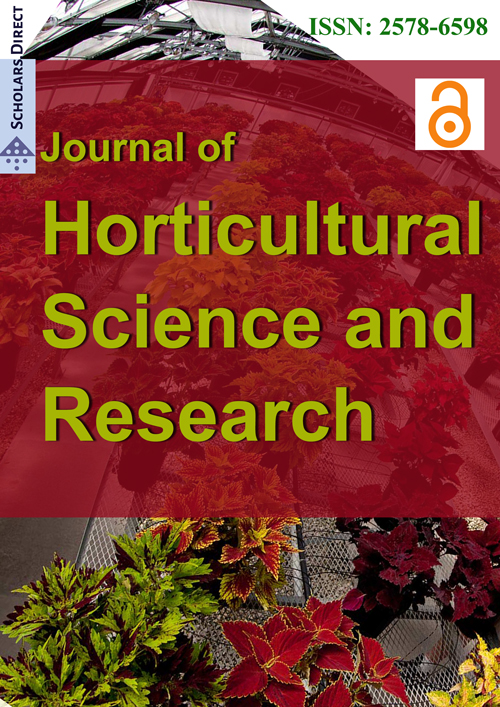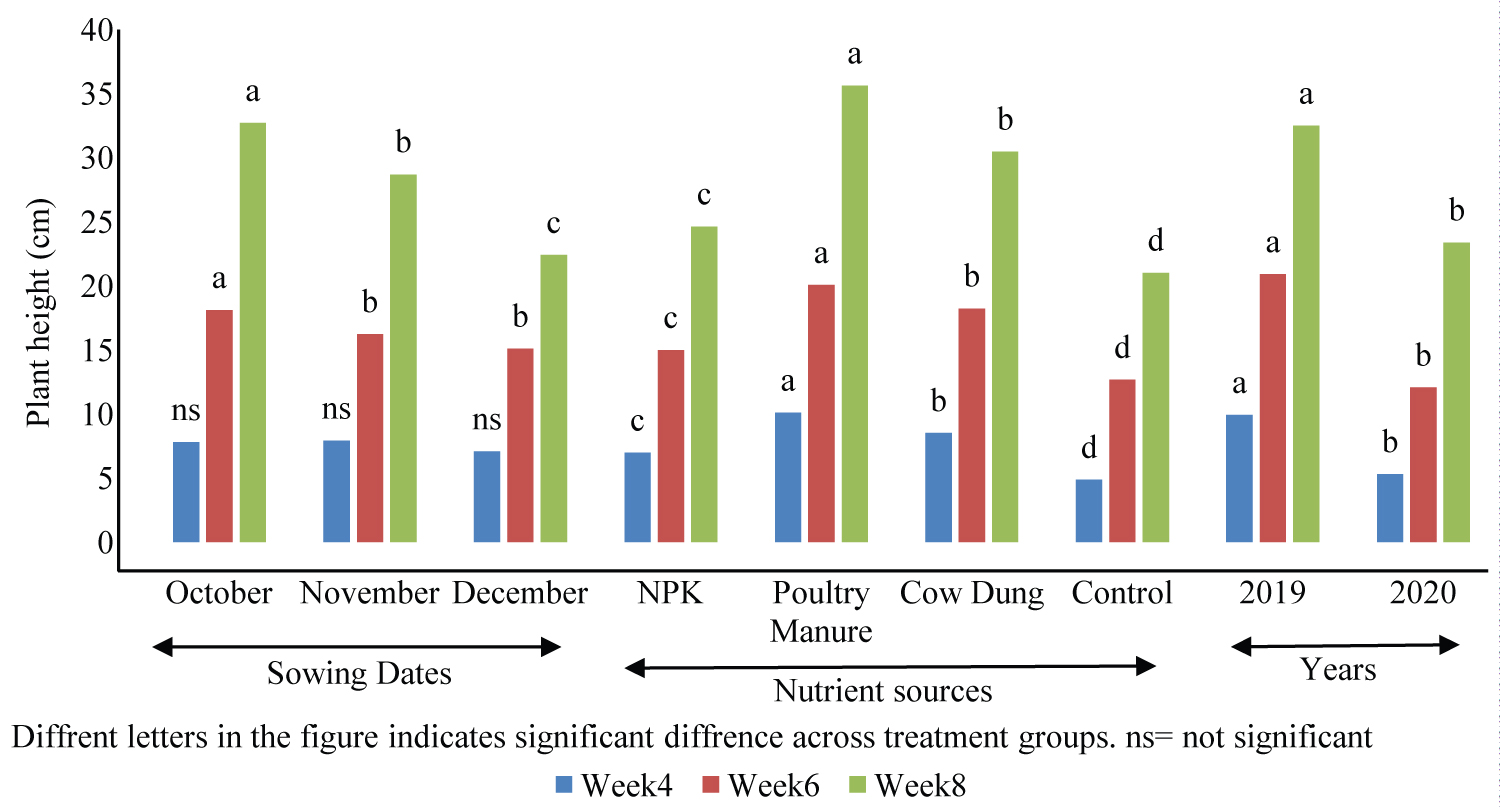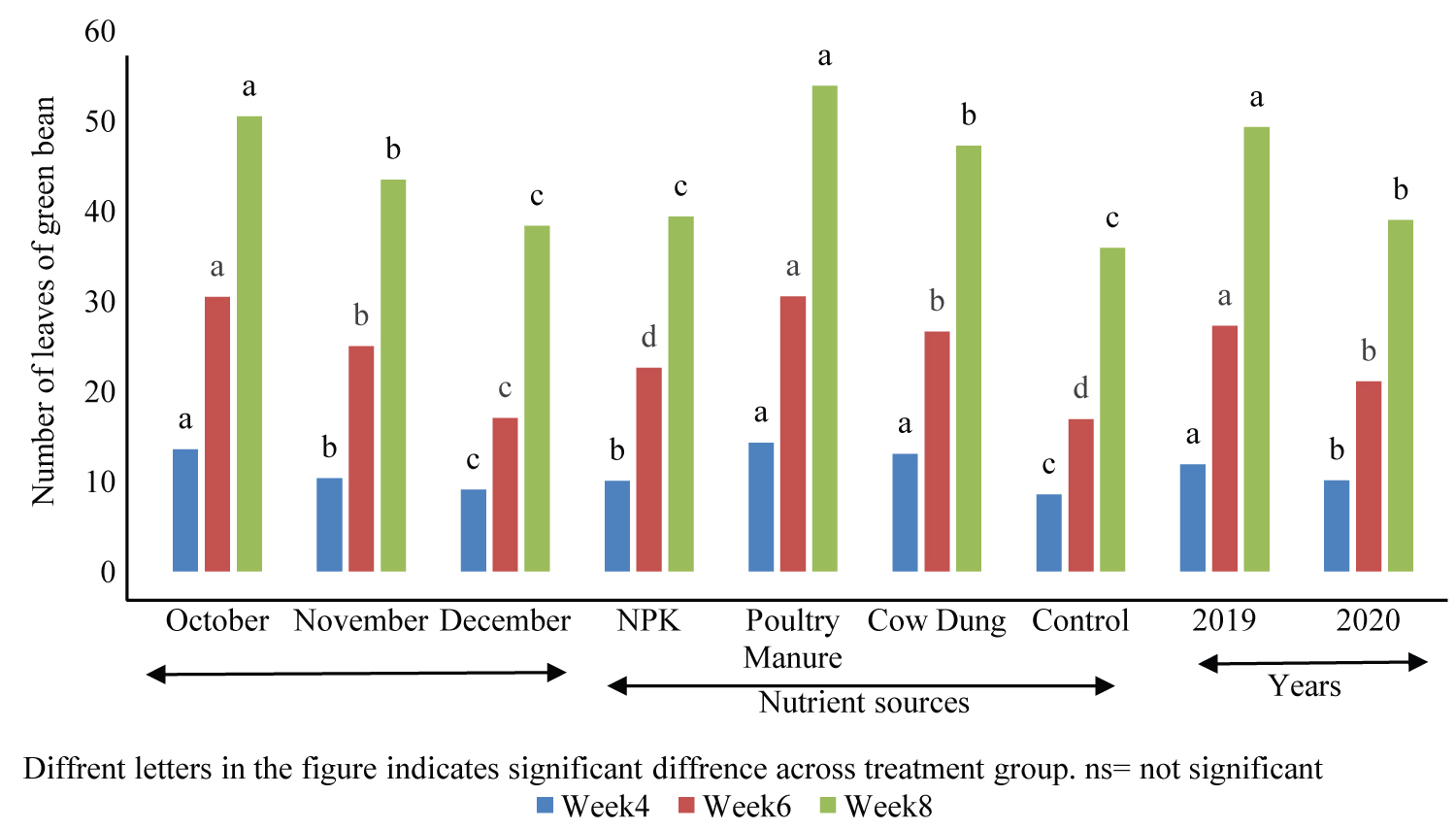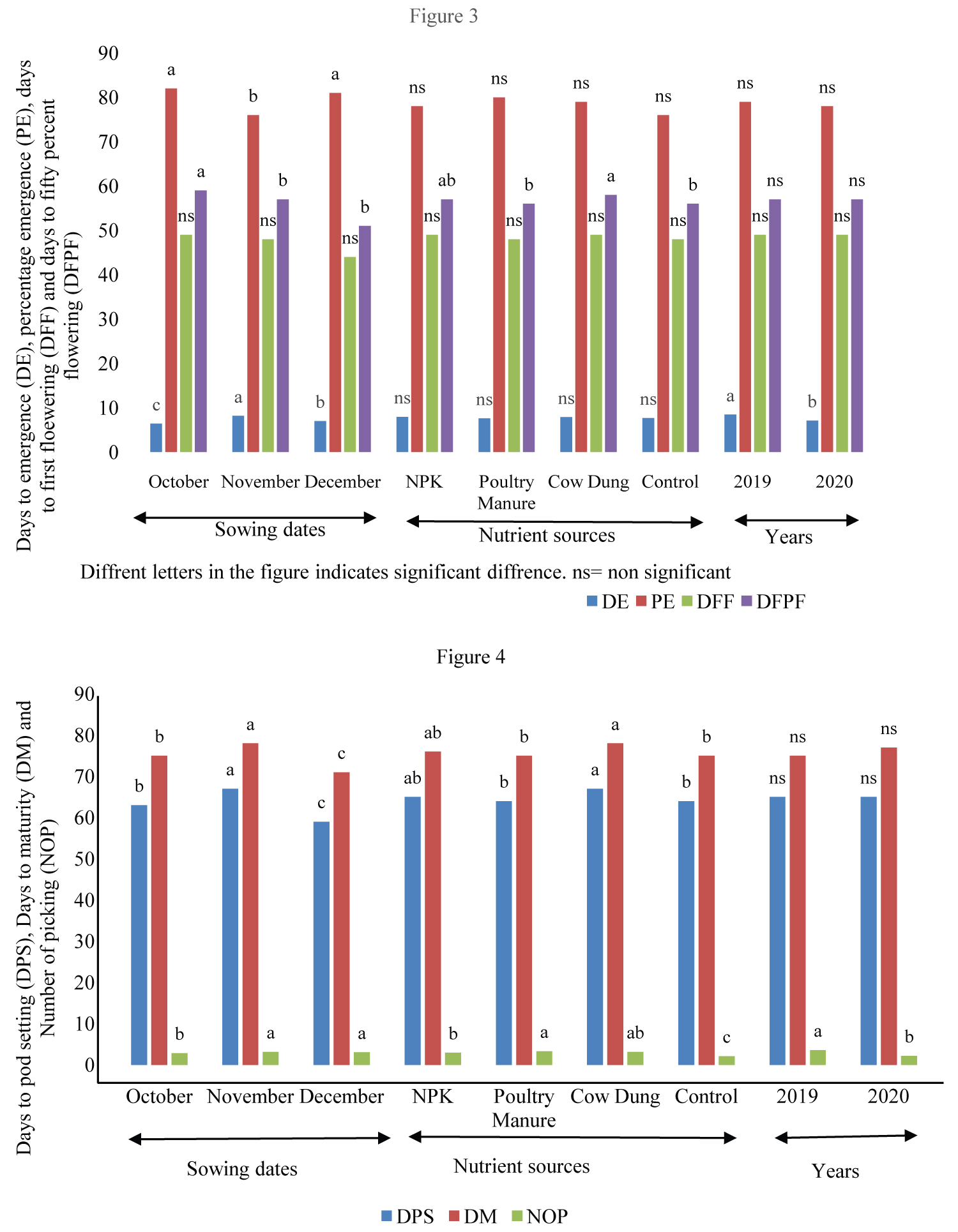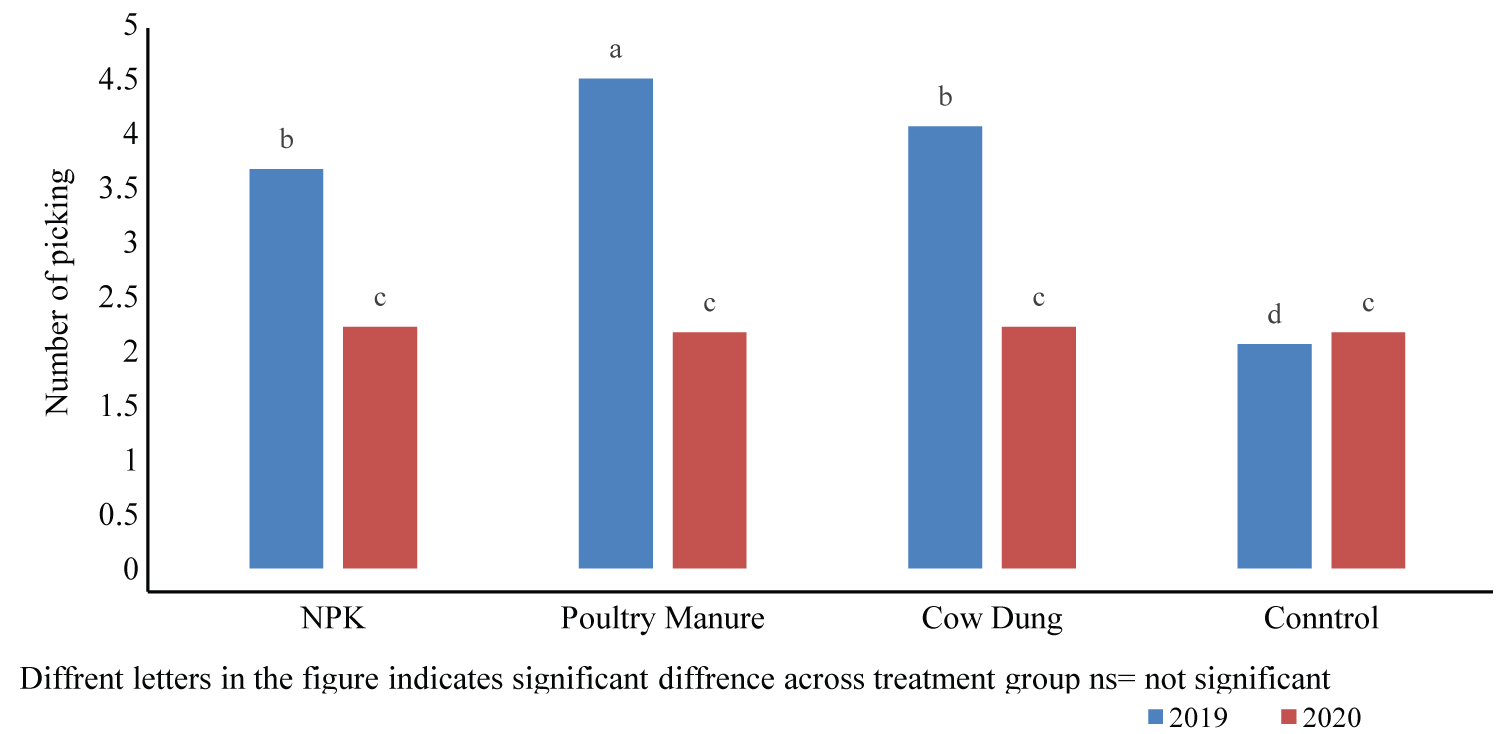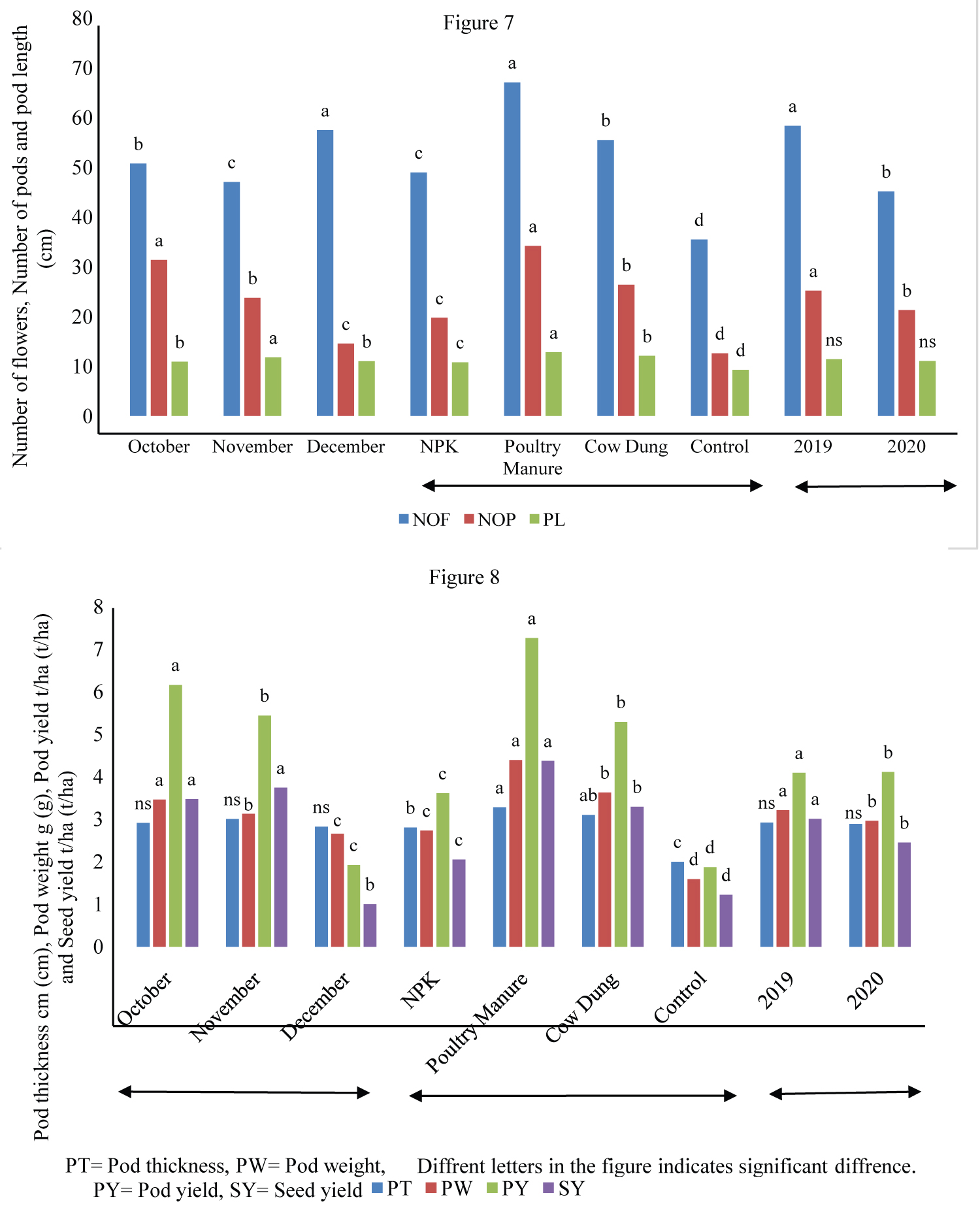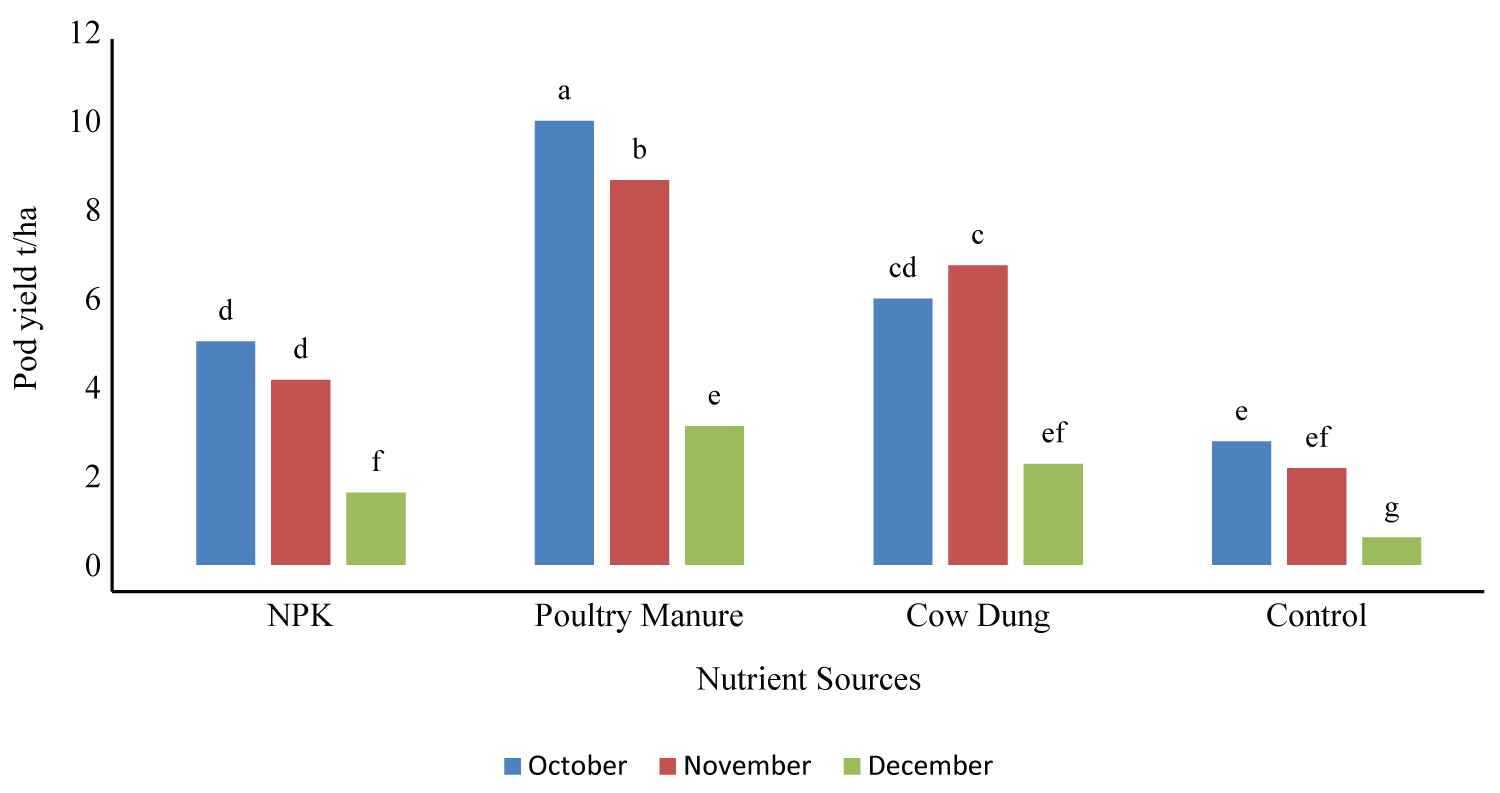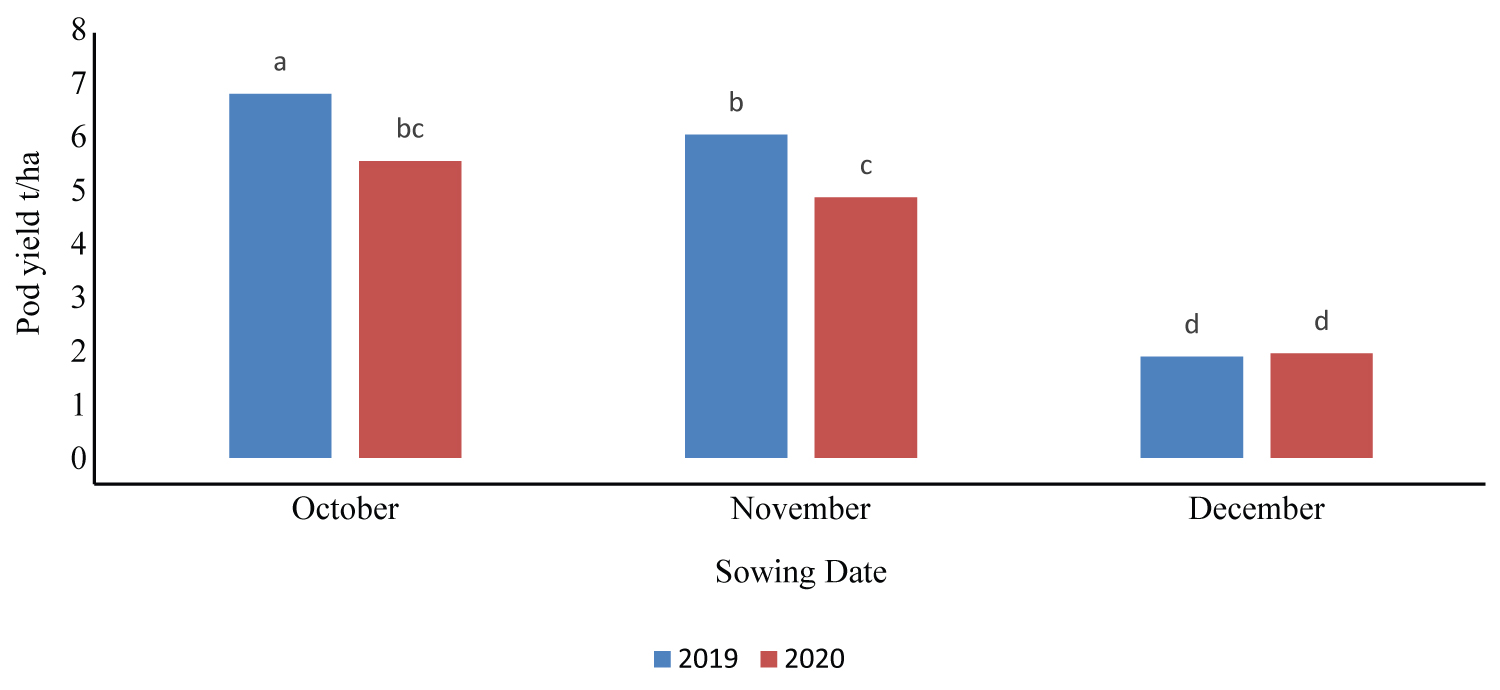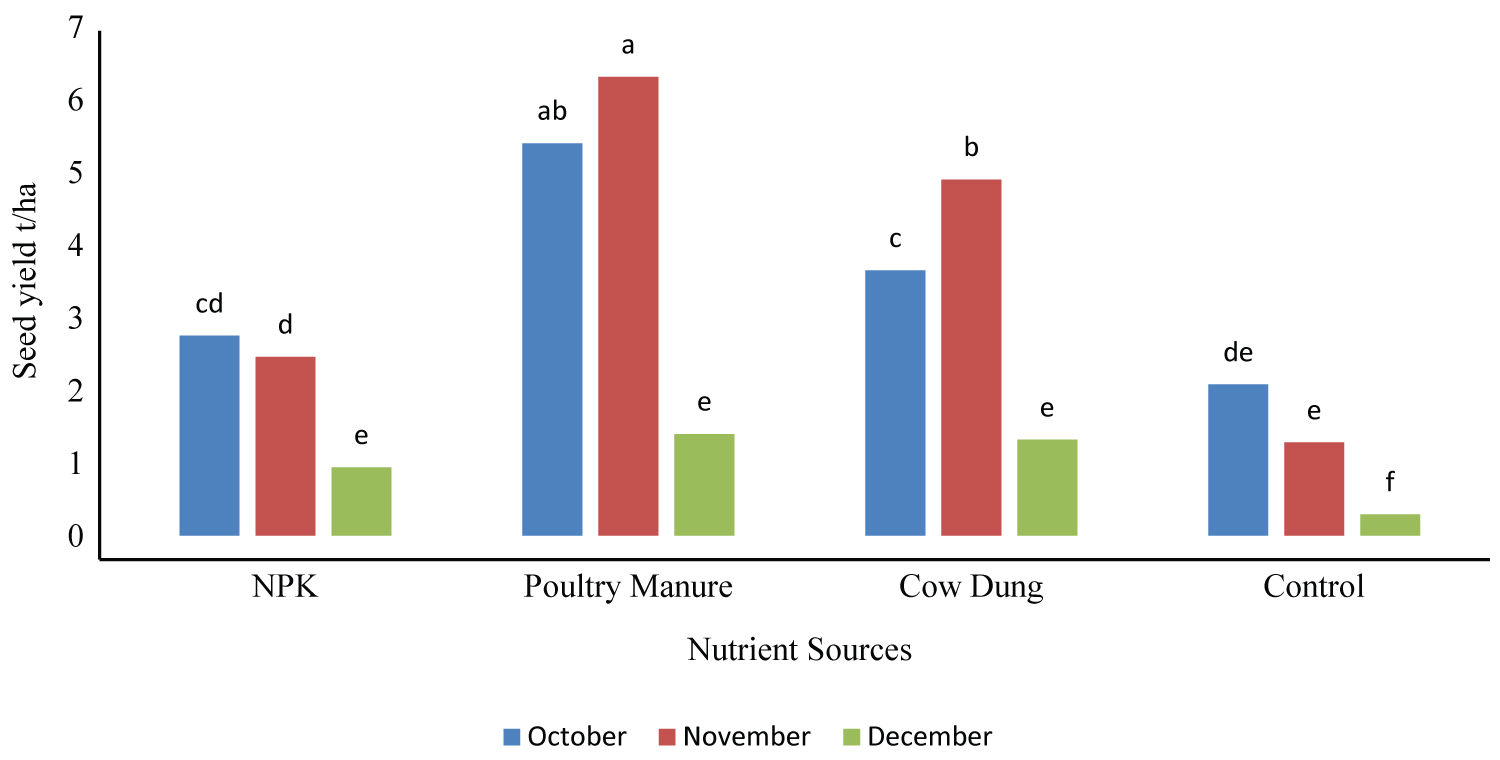Growth, Phenology and Yield Response of Green Bean (Phaseolus Vulgaris L.) to Various Sowing Dates and Nutrient Sources in Bauchi State, Nigeria
Abstract
Field experiments were conducted under irrigation during the 2019 and 2020 dry seasons at the teaching and research farm of Abubakar Tafawa Balewa University, Gubi Campus, Bauchi (10°22'N and 9°47'E). The experiments were conducted to determine the growth, phenology and yield response of green bean (Phaseolus vulgaris L.) to different sowing dates and nutrient sources. The treatments consist of three sowing dates (October, November and December and four nutrient sources (NPK 40:90:90 Kg/ha, Poultry Manure at 2t/ha, Cow dung at 2t/ha and Control). These were combined to give twelve 12 treatment combinations with three 3 replications. The result of the experiment revealed significant (p≤ 0.05) variation on both growth, phenology, yield and yield components of green beans. The result showed that sowing green beans in October gave significantly (p≤ 0.05) better values for almost all the growth, yield and yield components of green beans, except for number of flowers, where December sowing produced significantly more flowers than other sowing dates. The result further showed significant variation with regards to sources of nutrients applied. Applications of poultry manure at the rate of 2t/ha gave better values for most of the growth and yield parameters measured. The result of the interaction showed that sowing green bean in October with application of 2t/ha poultry manure produced the higher pod yield of up to 10t/ha, while November sowing leads to more number of picking (4.25) and produced more seed yield (6t/ha) during 2019 season and can therefore be recommended for improved green bean production in the study area.
Keywords
Sowing dates, Nutrient sources, Green bean, Phenology, Response, Year, Yield
Introduction
Green bean (Phaseolus vulgaris L.) is an annual vegetable of the family fabaceae and genus vulgaris. It is reported to have been originated from Central and South America and it is now grown all over the world including Africa [1,2]. In Nigeria, it is predominantly grown in Jos, plateau state and some parts of Zaria, in Kaduna states. Green bean is the third most important food legume crop worldwide surpasses only by soybean (Glycine max L.) and groundnut (Arachis hypogea L [3]. Its consumption both in fresh, dried and processed form has tended to increase latterly due to its nutritional value, simple cultivation technology, excellent storage properties and its wide range of culinary uses. In addition, their high content of carbohydrates, fiber, some minerals and vitamins make beans an excellent nutrient source [4]. Green beans though a day neutral vegetable crop, it responds differently to sowing time and yield variation have been reported with different sowing dates [5]. Extreme temperatures interfere with pod filling and affect both vegetative and reproductive growth [6]. Therefore, knowledge of the appropriate sowing dates of green bean need to be investigated so as to achieve optimum yield. Further, green bean responds positively to application of nutrients, even though it is classified as leguminous crops (crops that have the ability to source their nitrogen through association with bacteria). Several research findings revealed an improvement in both growth and reproduction of green beans with the application of either organic or inorganic nutrient sources. Mineral fertilizer such as NPK (chemical fertilizer) has been reported to increase plant growth and yield. However, its use as plant nutrient source is known to cause various challenges to humans, soils, ecosystems and environments [7]. Poultry manure and cow dung are waste products of poultry birds and bovine animals respectively which are used as organic fertilizers and its application to crops have been reported to improved crop productivity and yield [7] reported that repeated application of poultry manure and cow dung to crop land increased crop productivity, through improvement in soil health characteristics such as soil organic matter, increase total porosity, infiltration capacity and water holding capacity of a soil and significantly decrease bulk density [8]. Despite the numerous importances of green beans to nutrition, health and economy and increase in its demand and cultivation, its yield stagnates in the range of 5-8t/ha as against the expected potential yield of 15-20t/ha. This is attributed to the use of low yielding varieties, lack of knowledge of the optimum sowing dates, poor fertilization and low nutrient status of our soils among others. This study was therefore carried out to determine the response of green bean to different sowing dates and nutrient sources in Bauchi state Nigeria.
Materials and Methods
The experiments were conducted at the teaching and research farm of Abubakar Tafawa Balewa University, Gubi Campus Bauchi (10°22'N and 9°47'E) and 609.3m above sea level located at the Northern Guinea Savannah agro ecological zones of Nigeria. The trial was carried out during the dry seasons of 2019 and 2020. The materials for the experiments consisted of seeds of green beans (Yarsalina) obtained from Jos Agricultural Development Programme (JADP), poultry manure, cow dung and NPK fertilizer, single super phosphate (SSP) fertilizer and Murite of potash MOP were obtained from Bauchi State Agricultural Development Programme (BSADP).
The treatments consisted of three sowing dates (October, November and December) and four sources of plant nutrients (Mineral fertilizer (NPK) at the rate of 40:90:90. Cow dung (2t/ha), Poultry manure (2t/ha) and control) these were factorially combined to give twelve treatments combinations and were laid out in a randomized complete block design (RCBD) with three replications. Plot size of 3x3m was used as a seed bed. Fifty 50cm and hundred 100cm were adopted as border between plots and walkway between replicates respectively. SSP, MOP, poultry manure and cow dung were applied and incorporated to the plots at seed bed preparation. Seeds of green beans were treated with apron star at the rate of 10g per 2kg of seeds. Two seeds were planted per hole which were later thinned to one 1 plant per stand at two weeks after sowing. A composite soil sample were collected from the experimental field before the application of the fertilizers at the depth of 0-15 and 0-30cm and were analyzed in the laboratory for physico-chemical properties. Poultry manure and cow dung were taking to the laboratory for chemical composition analysis. Metrological data (temperature, relative humidity and amount of rainfall) were collected during the conduct of the experiments at the ATBU metrological units. Data were collected on growth, phenology, yield and yield components of green beans. All data collected were subjected to analysis of variance ANOVA using Statistical software SPSS. Significantly different means were separated by DMRT
Results and Discussion
Plant height and number of leaves of green beans
Figure 1 and Figure 2 showed the plant height and number of leaves of green beans as influenced by sowing dates, nutrients sources for 2019 and 2020 season. The results revealed significant (p≤ 0.05) variation between the sowing dates on plant height and number of leaves of green beans at various weeks after sowing (WAS), except for plant height at four 4 WAS, where sowing in October produced taller plants and more leaves than the other sowing dates. While shorter plants and fewer leaves were obtained with December sowing (Figure 1). This could be that seeds of green beans planted in October emerged and established quickly due to closeness of the sowing time and end of rainy season in the study area, thus the soil is still loose and moist which aids quick germination and emergence of seedlings. This finding is in line with that of [5] who obtained higher vegetative and reproductive growth in the late rainy season than early rainy season planting. Similarly, more vegetative growth recorded during October sowing could be due to warm temperature during the period as warmer temperature has been reported to encourage vegetative growth in green beans while lower temperatures reduces the growth rate in green beans. This result agrees with the work of [9] who reported that prevailing lower temperatures during the early growth period of green beans decreases the vegetative growth leading to shorter plants, fewer leaves and lesser branches [10] and [11] also confirmed that sowing green beans in middle of September to early October increases plant height, number of leaves and branches than sowing in November due to warm temperature at that period (Figure 1).
The results also indicated significant (p≤ 0.05) variation between the sources of nutrients applied. Application of poultry manure to green beans significantly (p≤ 0.05) produced taller plants, and more leaves (Figure 2) than the other sources of nutrients. While shorter plants and fewer leaves were gotten from control application of nutrient sources (Figure 1). This result confirmed the richness of poultry manure in both macro and micro nutrients needed for the growth of plants. Poultry manure contains almost all the essential nutrients needed for plant growth and hence increase vegetative growth of garlic [12] and improved soil condition which helps in easy and quick establishment of roots of green beans plants. This report is supported by the work of [13] who obtained longer root length, pods and higher number of branches under treatments that received poultry manure, compared to those plants treated with DAP (Di ammonium phosphate). The result also showed that year 2019 produced taller plants and more leaves than the year 2020 (Figure 1 and Figure 2).
Phenological parameters of green beans as influenced by sowing dates and nutrient sources
Figure 3 and 4 showed the phenological parameters of green beans as influenced by sowing dates and nutrient sources. The results showed significant (p≤ 0.05) variation on phenological parameters of green beans except for days to first flowering, where October sowing result to early emergence of seeds, gave higher percentage of seed emerged, while late emergence of seeds, least percentage emergence and more days to pod settings were recorded with November sowing (Figure 3). This could be as a result of warm of temperature in October and prevailing low temperature during both November and December sowing, as seed of green beans emerged within 4-7 days when the temperature is warm and it may take 10-14 days to emerged when the temperature is low. Also poor establishment of green bean seedlings was reported at temperature below 15°C. [14] reported that low temperature is unfavorable to emergence and vegetative growth of green bean. Similarly, November and December sowing recorded more number of picking than October sowing. More number of picking from both November and December could be due to low temperature which encourages pod formation and decrease the rate of flower abortion in green bean.
The result further revealed significant difference on phenology of green beans as influenced by nutrient sources, where application of cow dung takes more days to achieved 50% flowering, higher number of days to pod setting, days to maturity and more number of picking (Figure 3 and Figure 4). However, these were statistically similar with the application of NPK. Lesser days to 50% flowering, days to pod setting, and days to maturity was obtained from poultry manure and control, however, it is statistically similar with NPK application. For the number of picking however, application of poultry manure to green bean leads to more number of picking which is statistically similar to application of cow dung and NPK, while less number of picking was from control treatments (Figure 4). Statistically similar number of picking with the application of both nutrient sources indicates capability of both nutrient sources to supply the needed nutrient for continuous reproductive growth of the green bean as opposed to the control treatments which lack nutrient supply to aid pod formation. The result also showed significant difference between the years of research, where 2019 trial produced more days to emergence and more number of picking than the 2020 trial (Figure 4).
The result further revealed significant interaction between sowing dates and year on number of picking. Where, November sowing during 2019 season gave more number of picking while November and December sowing during 2020 season gave less number of picking. This result agrees with that of [15] who obtained variation on pod setting and pod number, yield and number of picking of green bean under different sowing dates (Figure 5). Interaction between nutrient sources and year on number of picking of green beans revealed that, application of poultry manure during 2019 season gave more number of picking while less number of picking was from 2020 season with the application of both nutrient sources and control during 2019 season (Figure 6).
Yield and yield components of green beans
Figure 7 and Figure 8 showed the yield and yield components of green beans as influenced by sowing dates and nutrient sources. The results revealed significant (p≤ 0.05) difference on number of flowers, number of pods, pod length, pod weight, pod yield and seed yield of green beans between the sowing dates. More number of flowers was gotten from December sowing, this is due to warm temperature at flowering time, as warm temperature encourages flowering in plants including green bean, while few flowers were obtained from November sowing (Figure 7). However, more number of pods were obtained from October and November sowing and fewer pods were from December sowing (Figure 7). The result also showed that, longer pods were obtained from October and November sowing, while shorter pods were produced by December sowing. Moreover, heavier pod weight was gotten from October sowing, while lighter pods were gotten from December sowing. Higher pod yield was obtained from October sowing while low pod yield was gotten from December sowing. More seed yield was produced by October and November sowing, and less seed yield was from December sowing (Figure 8). The higher pod and seed yield obtained from October sowing is as a result of warm temperature during early vegetative growth of the plants which encourages rapid development of vegetative parts such as formation of more branches, leaves and stem elongation, similarly, pods setting corresponds to periods of low temperatures (December) which favours production of good quality pods and reduces rate of flower abortion. This is in conformity with the findings of [16] who obtained higher pod yield of up to 13t/ha when faba bean was grown in 25th October and 8th of November. The result further revealed the influence of different nutrient sources on yield and yield components of green beans. The application of poultry manure proved to be more effective in improving the yield and yield related traits of green bean than the other sources of nutrients applied, while lower yield was obtained from control application of nutrient sources. This lend the support of [17] who reported the benefits of applying compost made from poultry manure to green bean which increases both vegetative and reproductive growth of green bean including number of flowers. Further, significant difference exists between the years of research, where year 2019 season gave better values for yield and yield characters measured.
Interaction on pod yield of green bean
The result of the interaction between sowing dates and nutrient sources on pod yield of green beans revealed that, October planting with application of poultry manure gave higher pod yield of up to(10.00t/ha) and lower yield(0.62t/ha) was from December sowing with control application of nutrient source (Figure 9). This indicates that, green bean responds positively to application of fertilizer, contrary to the view of most farmers that is a leguminous crop capable of supplying its nutrient demands and it is mainly grown in marginal soils. This confirmed the findings of [18] who reported an increase in green bean yield of up to 24% with the application of chicken manure. The results of the interaction between the sowing dates and years of research on pod yield of green bean indicated that October sowing during 2019 season gave the highest pod yield of up to 6.79t/ha, and the lowest yield was from December sowing in 2020 growing season (Figure 10). This finding is in line with that of [16] who obtained more pod yield in faba bean when transplanted in 25th October.
Interaction on seed yield of green bean
The results further revealed an interaction between sowing dates and nutrients sources on seed yield of green beans, where November sowing with the application of poultry manure produced higher seed yield of green beans (6.31t/ha) and it is statistically the same with October sowing with poultry manure application (Figure 11). While lower yield of (0.29t/ha) was from December sowing with control application of nutrient source. This is contrary to the findings of [19] who reported 1.8t/ha as the highest seed yield of pole type of green bean.
Conclusions and Recommendation
Based on the result of these findings, both growth, phenology, yield and yield components of green bean were influenced by different nutrient sources, years and sowing dates. October sowing with application of poultry manure proved to be effective in improving growth characters and some phenological parameters, yield and yield components of green beans. October sowing with application of poultry manure at the rate of 2t/ha gave the higher pod yield (10.00t/ha) and therefore it is recommended for green beans production in the study area. Further research is recommended for higher rates of nutrient sources and more sowing dates for improved yield and better productivity of green beans in the study area.
References
- FASOSTAT (2013) Food and Agricultural Organization of the United Nations.
- CS Wortmann (2006) Phaseolus vulgaris (common bean). PROTA, (Plant Resources of Tropical Africa Netherlands.
- MD Antonio, MG Ana, AR Paula, et al. (2016) History of the common bean crop: its evolution beyond its areas of origin and domestication. Arbor 192: a317.
- KA Batista, SH Prudêncio, KF Fernandes (2010) Changes in the functional properties and anti-nutritional factors of the extruded hard-to-cook common beans (Phaseolus vulgaris, L.). Journal of Food Science Oxford, 75: 286-290.
- G Essubalew, AA Tesfaye, T Mulualem (2014) The Effect of Sowing dates and Spacing for Yield of Green beans bean (Phaseolus vulgaris L.) varieties at Jimma, South Western, Ethiopia. Journal of Agricultural Research 3: 174-180.
- K Tiwari, A Chaubey Tribhuvan (2017) Quality seed production of French bean, Assistant Professor (Horticulture), Fiji National University, Fiji Principal Scientist, ICAR-IIVR, Varanasi.
- Y Lin, DB Watt, EV Santen, et al. (2018) Influence of poultry litter on crop productivity under different field conditions: A meta-analysis. Agronomy Journal 110: 807-818.
- PH Kincora, K Koga, N Satta (2014) A study on the effect of compaction on transport properties of soil gas and water, Relative gas diffusivity. air permeability, and saturated hydraulic conductivity. Soil Tillage Res 143: 172-179.
- MA Haque, BC Sarker, MR Karim, et al. (2020) Effect of Sowing time and Plant Spacing on Growth and Yield of Dwarf Hyacinth Bean. Plant Archives 2020 20: 2953-2958.
- M Monirruzzaman, MR Islam, J Hassan (2008) Effect of NPK, Zn and Boron on Yield attributes of French beans in South Eastern Hilly Region of Bangladesh. J Agric Rural Dev 6: 75-82.
- A Begum, A Ahad, MO Khaisar, et al. (2003) Effect of sowing dates and fertilizer treatments on the reproductive variability of French bean (Phaseolus vulgaris L.). Pakistan journal of biological science 6(22): 1897-1901.
- RA Bala, AS Fagam, YM Shuaibu, et al. (2019) Effect of NPK fertilizer and poultry manure levels on the growth, yield and Sulphur content of two garlic (Allium sativum L.) varieties in Bauchi State, Nigeria. Proceedings of the 29th Annual Conference of Farm Management Association of Nigeria, Federal University of Agriculture, Abeokuta, Ogun State Nigeria: 622-630.
- IU Rahman, A Afzal, Z Iqlab, et al. (2014) Growth and Yield of Phaseolus vulgaris as influenced by Different Nutrient Treatments in Mansehra. International Journal of Agronomy and Agricultural Research 4: 20-26.
- K Tiwari, A Chaubey Tribhuvan (2017) Quality seed production of French bean, Assistant Professor (Horticulture), Fiji National University, Fiji Principal Scientist, 2017 ICAR-IIVR, Varanasi.
- H Labuda, A Brodaczewska (2011) Sowing Dates as a Factor Determining French Bean bean ( Phaseolus vulgaris ) Yield for Processing. Folia Horticulturae 23: 73-81.
- A Carmine, A Diana, B Carlo, et al. (2018) Production System Effect on Growth, Pod Yield and Seed Quality of Organic Faba bean in Southern Italy. Folia Horticulture 30: 375-385.
- Eboibi O, Akpokodji O I, Uguru H (2018) Growth performance of five bean varieties ( Phaseolus vulgaris ) as influenced by organic ammendements. J Appl Sci Environ Manage 22: 759-763.
- L Sitinjak, and E Purba (2018) Response to Growth and Production of Green beans ( Vignaradiata ) in various cropping spots and fertilizer provision of layer chickens. Conference Series: Earth Environmental Science 122: 1-6.
- Akhilesh Sharma, GD Sharma, Yudhvir Singh, et al. (2013) Optimum Sowing Dates and Varieties for Seed Productivity of pole French bean ( Phaseolus vulgaris ) Under North West Himalayas. African Journal of Agricultural Research 8: 6196-6201.
Corresponding Author
Bala RA, Department of Crop Production, Faculty of Agriculture and Agricultural Technology, Abubakar Tafawa Balewa University, Bauchi, Nigeria.
Copyright
© 2022 Bala RA, et al. This is an open-access article distributed under the terms of the Creative Commons Attribution License, which permits unrestricted use, distribution, and reproduction in any medium, provided the original author and source are credited.

